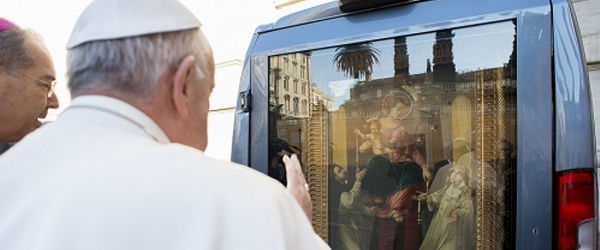Richard Widerynski was standing in the back of the Cathedral of Our Lady of the Angels, waiting with his Polish group to process down the center aisle for the Celebration of Cultures Mass on the morning of Sept. 28.In front of him were groups representing Lithuania, Nigeria, Thailand, Samoa; behind were Mexico, Arabia, China, Vietnam, Portugal Croatia, Korea, Philippines, Africa, Armenia, Costa Rica, Indonesia and El Salvador, among others. The folks with Eritrean roots brought up the rear. “It’s a great, great event,” he said, looking around. The vice-president of the local Polish American Congress was wearing the traditional dress of a 17th century Polish nobleman: a brushed velvet burgundy (the color of his town in Poland) robe topped off with a black fur hat that had a single feather sticking up. “Not only is the Mass incredibly uplifting, but just seeing people in their native garb and with such pride. And, also, the heterogeneity — the amount of people who belong to different ethnic groups who we never knew. Who knew there were Arab Catholics?”The impromptu interview was cut short by the rapid-fire sound of pounding drums, which seemed to bounce off the earth-tone high walls. Yellow and red fabricated lions, with two agile males under each, led the procession with the Chinese Dragon Dance. The lions made snake-like twists and turns, occasionally rising up. Their ancient mission was to chase away evil spirits.And by all appearances, they succeeded. Every one of the groups made it down the aisle to the front of the sanctuary. So did some 20 priests, most of them chaplains of the ethnic groups, followed by Cardinal Roger Mahony and Auxiliary Bishop Alexander Salazar, who heads up the archdiocese’s Office of Ethnic Ministry. ‘A beautiful sign’Bishop Salazar, the principal celebrant, walked up that same center aisle during his homily. He pointed out that Pope Francis, “first and foremost,” teaches that all of humankind are brothers and sisters.“And we come from all different parts of the world,” he declared. “What a great symbol we are to one another. And what a beautiful sign we make. If we could take a snapshot from the top of the cathedral looking down, we would see this colorful gathering of peoples forming a living cross….“And yet we realize that we are only a portion of the body of Christ. Also decorating the cathedral walls are men and women from all different nations who are a temple of the Lord. [John Nava’s tapestries represent the Communion of Saints, with figures of the apostles and martyrs mixed with ordinary individuals.] And what they are, we want to be. So as we gather to be nourished and celebrate the great gift of God’s diversity, and God’s presence in our diversity, then we also realize that we are truly made one by the body of Christ.”The bishop reported that 42 different languages were spoken in the Los Angeles Archdiocese’s 287 parishes, which encompassed Los Angeles, Ventura and Santa Barbara counties. And he noted that the archdiocese was not only the nation’s largest, but also the most diverse.“And it is not correct to have laws that divide and separate with this God,” he stressed. “So we must work together for a just immigration reform that will be able to reunite us with one another in the spirit of community. We strive to work for justice and peace….“Let us ask the Lord to help each one of us to realize how important we are, to realize that it is from God’s gift that we are here together, with respect for each other’s customs and cultures, traditions and backgrounds. And let us learn from one another, and we will become the people of God that he has made us to be.” ‘Giving them tradition’Right after Mass, whose theme was “Our faith and our youth are our strength,” Martha Uzondu was out in the cathedral’s plaza trying to catch up with other members of the Nigerian community from St. Eugene Church in Los Angeles. She had on a traditional splash-of-colors head-tie and wrapper dress.“Why are you here this morning?” the middle-age mother was asked.“Why?” she echoed. “I’m in the choir at St. Eugene’s and every year we come here to celebrate. Look at all the different people here. We used to bring our kids, but now they’ve grown. But I still like to come.” Not far away were Mary and John Winzes from the City of Los Angeles St. Kateri Circle. She is Ojibway; he’s Muskogee.“I was overwhelmed,” John said. He was wearing a ceremonial “Ribbon Shirt,” with three- or four-inch strips of shiny colored cloth attached. Around his neck hung two necklaces. One had small turquoise stones and coral. The other featured a medallion with intricate blue-and-orange beadwork. “I just thought it was a wonderful day, a wonderful experience,” he continued. “And there just seemed to be a lot of joy in everyone’s heart today. I looked around me at the people, and I could see the joy in them. “Just to be expressing their culture. I mean, every day you dress like everybody else dresses,” he said. “You go out and blend. And sometimes with your children, you want them to see something different. You want them to understand what their culture is. And you have to work at that. You can lose it quickly in Los Angeles.”Mary, who had on a buckskin dress, nodded her head in agreement. “It’s bringing in tradition,” she said. “It’s giving them tradition.” {gallery width=100 height=100}gallery/2013/1004/cultures/{/gallery}

